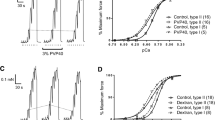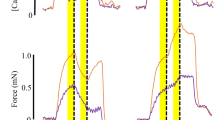Abstract
Strips of intact and chemically skinned (Triton X-100) taenia coli were mounted for isometric and quick-release experiments at 23°C. Active force increased in repeated high-K+ induced contractures in the intact muscle. Stable maximal force was 313±24 mN/mm2 (n=6). The skinned preparations activated by Ca2+, at 2 mM Mg2+, 3.2 mM MgATP and ionic strength 0.085 M, gave half maximal force atpCa=5.62±0.4 and a maximal force (63±8 mN/mm2) atpCa=4.5 (20–25 of the control K+-responses prior to skinning but about 60% of the first K+-response). Force-velocity relations were obtained from intact muscles and from the same muscles chemically skinned and activated at optimal Ca2+. Maximal shortening velocity (V max) was unaltered in the skinned preparation compared to the intact muscle (0.138±0.011 vs 0.140±0.006 L/s) indicating similar kinetics of actomyosin interaction. In the intact muscle a decrease inV max was found when the Ca2+ concentration was reduced. Calmodulin (1μM) increased Ca2+ sensitivity (by about 0.6 log units) of the skinned preparation but at optimal Ca2+ caused no alteration in isometric force orV max
Similar content being viewed by others
References
Åberg AKG, Axelsson J (1965) Some mechanical aspects of an intestinal smooth muscle. Acta Physiol Scand 64: 15–27
Adelstein RS, Eisenberg E (1980) Regulation and kinetics of the actinmyosin-ATP interaction. Ann Rev Biochem 49: 921–956
Barany M (1967) ATPase activity of myosin correlated with speed of muscle shortening. J Gen Physiol 50: 197–218
Barron JT, Barany M, Barany K (1979) Phosphorylation of the 20,000-dalton light chain of myosin of intact arterial smooth muscle in rest and in contraction. J Biol Chem 254: 4954–4956
Barron JT, Barany M, Barany K, Storti RV (1980) Reversible phosphorylation and dephosphorylation of the 20,000-dalton light chain of myosin during the contraction-relaxation-contraction cycle of arterial smooth muscle. J Biol Chem 255: 6238–6244
Burnstock G, Campbell G, Rand MJ (1966) The inhibitory innervation of the taenia of the guinea-pig caecum. J Physiol (Lond)182: 504–526
Cassidy PS, Kerrick WGL, Hoar PE, Malencik DA (1981) Exogenous calmodulin increases Ca2+ sensitivity of isometric tension activation and myosin phosphorylation in skinned smooth muscle. Pflügers Arch 392: 115–120
Dabrowska R, Sherry JMF, Aromatorio DK, Hartshorne DJ (1978) Modulator protein as a component of the myosin light chain kinase from chicken gizzard. Biochemistry USA 17: 253–258
Dillon PF (1980) Calcium dependence of force and velocity in vascular smooth muscle. Fed Proc 39: 1733
Dillon PF, Aksoy MO, Driska SP, Murphy RA (1981) Myosin phosphorylation and the cross-bridge cycle in arterial smooth muscle. Science 211: 495–497
Driska SP, Aksoy MO, Murphy RA (1981) Myosin light chain phosphorylation associated with contraction in arterial smooth muscle. Am J Physiol 240: C222-C233
Endo M, Kitazawa T, Yagi S, Iino M, Kakuta Y (1977) Some properties of chemically skinned smooth muscle fibers. In: Casteels R, Godfraind T, Rüegg JC (eds) Excitation-contraction coupling in smooth muscle. North-Holland Publishing Co., Amsterdam, pp 199–209
Fabiato A, Fabiato F (1979) Calculator programs for computing the composition of the solutions containing multiple metals and ligands used for experiments in skinned muscle cells. J Physiol (Paris) 75: 463–505
Fletcher R, Powell JD (1963) A rapidly convergent descent method for minimization. Computer J 6: 163–168
Gabella G (1976) The force generated by a visceral smooth muscle. J Physiol (Lond) 263: 199–213
Gabella G (1981) Structure of smooth muscles. In: Bülbring E, Brading AF, Jones AW, Tomita T (eds) Smooth muscle. Edward Arnold, London, pp 1–46
Godt RE, Maughan DW (1977) Swelling of skinned muscle fibers of the frog. Experimental observations. Biophys J 19: 103–116
Godt RE, Maughan DW (1981) Influence of osmotic compression on calcium activation and tension in skinned muscle fibers of the rabbit. Pflügers Arch 391: 334–337
Gordon AR (1978) Contraction of detergent-treated smooth muscle. Proc Natl Acad Sci USA 75: 3527–3530
Hellstrand P, Johansson B (1975) The force-velocity relation in phasic contractions of venous smooth muscle. Acta Physiol Scand 93: 157–166
Hellstrand P, Johansson B (1979) Analysis of the length response to a force step in smooth muscle from rabbit urinary bladder. Acta Physiol Scand 106: 221–238
Hellstrand P, Johansson B, Ringberg A (1972) Influence of extracellular calcium on isometric force and velocity of shortening in depolarized venous smooth muscle. Acta Physiol Scand 84: 528–537
Hoar PE, Kerrick WGL, Cassidy PS (1979) Chicken gizzard: Relation between calcium-activated phosphorylation and contraction. Science 204: 503–506
Iino M (1981) Tension responses of chemically skinned fibre bundles of the guinea-pig taenia caeci under varied ionic environments. J Physiol (Lond) 320: 449–467
Johansson B, Hellstrand P, Uvelius B (1978) Responses of smooth muscle to quick load change studied at high time resolution. Blood Vessels 15: 65–82
Jones AW, Somlyo AP, Somlyo AV (1973) Potassium accumulation in smooth muscle and associated ultrastructural changes. J Physiol (Lond) 232: 247–273
Lowy J, Mulvany MJ (1973) Mechanical properties of guinea pig taenia coli muscles. Acta Physiol Scand 88: 123–136
Marston SB, Trevett RM, Walters M (1980) Calcium ion-regulated thin filaments from vascular smooth muscle. Biochem J 185: 355–365
Mashima H, Handa M (1969) The force-velocity relation and the dynamic constants of the guinea-pig taenia coli. J Physiol Soc Jpn 31: 565–566
Mikawa T, Toyo-oka T, Nonomura Y, Ebashi S (1977) Essential factor of gizzard troponin fraction. J Biochem 81: 273–275
Parker RB, Waud DR (1971) Pharmacological estimation of drugreceptor dissociation constants. Statistical evaluation. I. Agonists. J Pharmacol Exp Ther 177: 1–12
Peiper U, Ehl M, Johnson U, Laven R (1976) Force velocity relations in vascular smooth muscle: The influence of pH, pCa and noradrenaline. Pflügers Arch 364: 135–141
Peterson JW (1980) Vanadate ion inhibits actomyosin interaction in chemically skinned vascular smooth muscle. Biochem Biophys Res Commun 95: 1846–1853
Peterson JW (1982) Simple model of smooth muscle myosin phosphorylation and dephosphorylation as rate-limiting mechanism. Biophys J 37: 453–459
Saida K, Nonomura Y (1978) Characteristics of Ca2+-and Mg2+-induced tension development in chemically skinned smooth muscle fibers. J Gen Physiol 72: 1–14
Schneider M, Sparrow M, Rüegg JC (1981) Inorganic phosphate promotes relaxation of chemically skinned smooth muscle of guinea pig taenia coli. Experientia 37: 980–983
Sjölin L, Hellstrand P, Clementz B (1978) An apparatus for mechanical experiments on isolated smooth muscle. Acta Physiol Scand 102: 32A-33A
Sparrow MP, Mrwa U, Hofmann F, Rüegg JC (1981) Calmodulin is essential for smooth muscle contraction. FEBS Lett 125: 141–145
Spedding M (1981) Comparison of “Ca++-antagonists” and trifluoperazine in skinned smooth muscle fibres. Br J Pharmacol 75: 25P
Uvelius B (1979) Shortening velocity, active force and homogeneity of contraction during electrically evoked twitches in smooth muscle from rabbit urinary bladder. Acta Physiol Scand 106: 481–486
Uvelius B, Hellstrand P (1980) Effects of phasic and tonic activation on contraction dynamics in smooth muscle. Acta Physiol Scand 109: 399–406
Author information
Authors and Affiliations
Additional information
Apreliminary report of some of the results presented here was given at the Scandinavian Physiology Society Meeting in Århus, November 1981. Arner A, Hellstrand P (1982) Acta Physiol Scand (Abstract) 114: 38 A.
Rights and permissions
About this article
Cite this article
Arner, A. Mechanical characteristics of chemically skinned guinea-pig taenia coli. Pflugers Arch. 395, 277–284 (1982). https://doi.org/10.1007/BF00580790
Received:
Accepted:
Issue Date:
DOI: https://doi.org/10.1007/BF00580790




